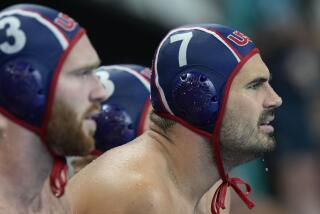Polo Isn’t a Cheap Hobby, but More Are Trying It : Playing the Ponies
- Share via
DEL MAR — In contrast to the gloss and glitter of her interior design business, and under the well-tailored fit of her business suit, Geri Musser is a bruised 37-year-old woman.
She couldn’t be much happier.
“Most people would look at me in a suit or a silk dress during the day and never know I eat horse-manure dust afterwards,” Musser says with a laugh.
Such is the price one pays for playing polo.
Musser is part of a small but growing polo-playing population in San Diego County. Although she took up the sport only six months ago, Musser is hooked despite the bumps and bruises she receives.
“It’s a hard game, but it’s so exhilarating,” she said.
Her eyes sparkled as she talked while watching an exhibition game last weekend among some of the best local players.
“It’s not much of a spectator sport,” Musser continued. “The real enjoyment comes in the playing. You try to tell people about it, and they think you’re a snob, or they just don’t relate.”
Musser grew up in San Diego and rode hunters and jumpers as a teen-ager. But until last fall, she hadn’t ridden horses seriously for 20 years.
“I’ve wanted to play polo since my mid-20s, but there was never any place to play,” Musser said. “It was an elusive dream.”
Now, thanks to the San Diego Polo Club and its sister operation, the Rancho Santa Fe Polo Club, there is a home for those who yearn to swing a skinny mallet at a little white ball while leaning from a galloping horse.
Many of those playing at the San Diego Polo Club are, like Musser, beginners. The club, located in Del Mar just east of Interstate 5 at the Via de la Valle exit, has been open for a year and a half and offers lessons on two “indoor polo” fields.
Next door, the Rancho Santa Fe club has five large fields for the more traditional grass version of the game.
“Indoor polo is a close-knit group,” Musser said. “You get more of the hobbyist. Across the street, it’s much more serious.”
Craig Ramsby is serious. He has played polo professionally for 15 years and is spending his first summer in San Diego at Rancho Santa Fe.
On the professional level, players earn prize money at tournaments around the country and the world, but most of their income is derived from private and corporate sponsorships.
Ramsby, who is sponsored by local building contractor Brian Murphy, won’t reveal financial details, saying only: “I have no complaints.”
Along with the two Del Mar facilities, there is a small club in Lakeside that was founded by the late Bud Hering.
Club officials estimate that there are fewer than 100 players in San Diego County but say the number is growing.
Polo’s origins are not known precisely, although it is thought the game was invented in the 1st Century in Persia (now Iran). The game was brought to the United States in 1876 by the British and usually is associated with the very rich and often famous.
The indoor--or arena--version of polo was invented in the 1920s in the United States. Indoor can be a misnomer, because the game is played in open-air arenas that sometimes are covered by a roof.
The enclosed field for indoor polo looks much like a hockey rink. It’s 100 yards long and 50 yards wide, with small goals at each end.
The grass game is played on a sprawling field 300 yards long and 150 yards wide. The goals are 24 feet across.
Ramsby, who plays indoors and out, said both games are appealing.
“The beauty of the grass game is the horses in motion going fast,” Ramsby said. “In the arena, you (the spectator) are right up next to the action.”
Indoor polo uses an inflated leather ball about the size of a softball; a plastic one is used on the grass. Otherwise, the equipment and rules are about the same.
The object, of course, is to whack the ball with a long-handled mallet through the goal while riding a horse. That isn’t easy. Players must exhibit strength, stamina, courage and hand-eye coordination. Good horsemanship is vital.
Indoor games are played in four seven-minute periods called chukkers. Outdoors, there are six chukkers per game.
There are three players per team indoors and four on the field, with no goalies in either case. Penalties are called by two mounted umpires. Infractions usually are the result of one player interfering with another’s right of way.
So that players of varying abilities can play together, there is a handicapping system that rates each person’s ability. Beginners are ranked from a low of C through A. More experienced players are rated from 1 goal to 10 for the world’s best. Ramsby is a 4-goal player on the grass, as is Prince Charles of Great Britain.
Players wear helmets and kneepads for protection. Serious injuries are not common, but with horses going full tilt, there is some obvious danger. As Musser put it: “There isn’t a day I go home from here without a black-and-blue mark. This is not a game for the feeble of heart.”
Mention polo to most people, and the first thought will be of snobby elitists.
Musser says the image--especially among those who play the indoor game--is mostly false.
“They’re very laid-back people,” she said. “Occasionally you’ll find a hotshot, but that’s rare. In general, everyone is friendly and willing to help a beginner.”
She and anyone else associated with polo will admit, however, that it is a costly passion.
“It takes more than middle income,” Musser said. “I’m not wealthy, but I’m not poor, either. It’s expensive, but if you want to do something, you can. I’ve given up tennis and a few vacations because my goal this year is to own my own horse.”
In polo, it’s important to find a horse that will “play well.” Actually, serious players must find several because they use a different horse for each chukker. A polo pony can cost anywhere from $4,000 to $25,000.
Stabling and feeding the horses are other big expenses, as is the equipment.
Like golf or tennis clubs, polo clubs charge dues for their members. At the San Diego Polo Club, which has 16 members and 32 students, membership runs $3,000 for five years.
In hopes of attracting new players, the club is offering 10 hours of introductory lessons for $200, said Ray Jessen, the club president.
“We go over the history and rules of the sport and put them on a horse and do a little riding,” he said.
It’s much more costly at Rancho Santa Fe--$5,000 for the four-month summer season--simply because it is more expensive to acquire and maintain the land for the huge fields. Rancho has about 50 members.
“It’s very expensive,” Ramsby said. “If you have to find out how much it costs, then it’s out of your league.”
But he is quick to add: “If you want to make money, you put on a blue suit. If you want to have fun, you play polo.”


